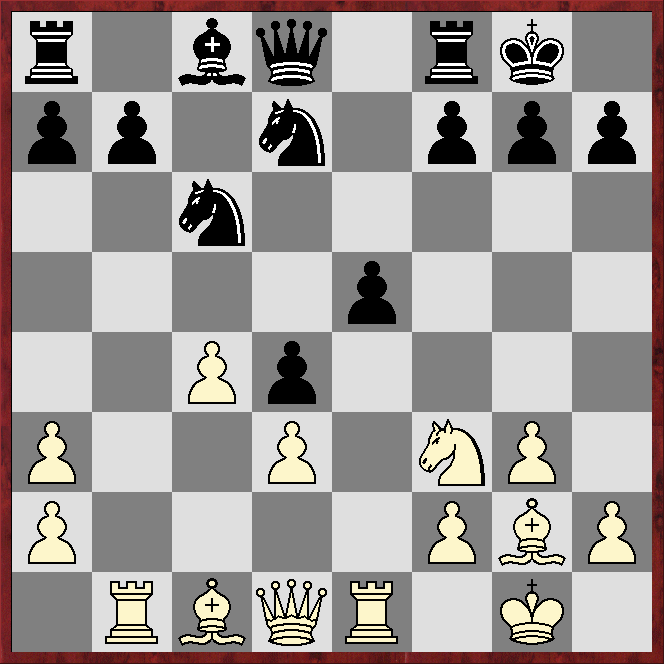Réti
1.c4 e6 2.Nf3 d5 3.g3 d4!?
This is only fifth-most popular in ChessBase's 2025 Mega database (3...Nf6 is normal) but has been played by Magnus Carlsen.
4.Bg2 c5
 |
| Starting the game with four pawn moves looks suspicious, especially for Black, but there seems no way for White to immediately take advantage |
*****
*****
*****
*****
5.0-0 Nc6 6.e3 Nf6 7.exd4 cxd4 8.d3 Be7 9.Na3!? Bxa3!? 10.bxa3 0-0
*****
*****
*****
*****
White's bishop-pair is pitted against Black's better pawn-structure and central space. Stockfish17 and Dragon1 reckon White is slightly better.
11.Re1 Nd7!?
Fighting to get in ...e5. After 11...Re8 12.Bf4 the move 12...Nd7 can be met by 13.Bd6!?, although the bishop may not be very stable on such an advanced post. However Dragon1 points out the possibility of 12...Ng4 13.h3 e5!?
12.Rb1 e5
 |
| Achieving the aim, but at a high cost in time - the engines reckon White is at least slightly better |
*****
*****
*****
*****
13.Ng5 h6 14.Ne4 Nf6
The engines reckon this is an improvement over the known move 14...Qc7?!, which is probably too passive. They also like the ambitious 14...f5!?
15.f4 Re8 16.Qf3
The engines suggest 16.a4!?, although not with the idea of developing the dark-square bishop to a3 (it goes to f4 or d2 in most lines). Presumably the point is to simply gain queenside space, and perhaps to take the b5 square away from Black in the event of White playing c5.
16...Nxe4 17.Qxe4 Rb8
The engines reckon 17...Qf6 gives equality.
18.f5!? f6 19.Qg4
*****
*****
*****
*****
19...Ne7!
The only move to keep the game going. Any move of the king loses a piece to 20.Bxc6 etc.
20.Be4
After 20.Bxh6 Nxf5 21.Bd5+ Kf8 22.Bd2 Ne7 (White threatened 23.Bb4+) Black is holding on.
20...Kh7 21.Qh5 Rf8
Probably not 21...Rg8?! 22.Bxh6!? gxh6 23.Qf7+ Rg8 24.Qxf6 Nc6 (forced) 25.Qxd8 Nxd8 26.f6+.
22.g4 Qe8 23.Qh3 Kg8 24.Qg2 Qd7 25.c5!? Qc7 26.Qc2?!
The engines reckon 26.Bd2!? gives equal chances, the point being 26...Qxc5?! is incredibly risky in view of 27.Bb4 Qc7 28.Rec1.
26...Bd7 27.Bd2 Rfc8 28.Qc4+ Kh7
*****
*****
*****
*****
29.Rec1?!
Probably better is 29.Qf7, meeting 29...Be8 with 30.Qe6. Black has to be careful, eg 29...Nc6? can be met by 30.Bxh6!?, and by the even stronger 30.g5!, when 30...hxg5? allows mate by 31.Qh5+ Kg8 32.Bd5+ etc.
29...Bc6 30.Bxc6?!
And here the engines prefer going for counterplay with 30.h4 or 30.Qf7.
30...Qxc6 31.Kf2 Qd5?!
30...Qxc6 31.Kf2 Qd5?!
Black is well on top after 31...Nd5, according to the engines.
32.Qb3?!
The engines reckon getting the queens off the board gives equality.
32...Rc7?! 33.Qxd5! Nxd5
*****
*****
*****
*****
34.Rc4?!
But it is probably easier for Black to play. Correct seems to be getting on with centralising the king by 34.Kf3, and if, as in the game, 34...Rbc8, then 35.h4 is fine as 35...Rxc5 36.Rxc5 Rxc5 37.Rxb7 is completely equal, according to the engines.
34...Rbc8 35.Rbc1 Kg8?!
The engines like 35...Ne7 and 35...h5!?, eg 35...h5!? 36.h3 (36.gxh5 Ne7) g6 as Black is better placed to take advantage of open lines on the kingside.
36.Ra4?
Much better is 36.Kf3.
36...b6 37.cxb6 axb6?
Black has a large advantage after 37...Rxc1, eg 38.bxa7 Rh1! 39.a8=Q Rxa8 40.Rxa8+ Kh7, one continuation being 41.a4 (41.Kg2 Rd1) Rxh2+ 42.Ke1 Rh1+ 43.Ke2 Ra1 44.Kf3 Rxa2 45.Be1 Nf4 etc. Alternatively 37...Bxc1? can be simply met by 38.Nxb6, when both the white rook and bishop hang.
38.Rac4 Nc3?
This loses a pawn, whereas after 38...Rxc4 39.Rxc4 Ra8 40.a4 Kf7 Black may have a slight edge.
39.Bxc3 dxc3 40.R1xc3 Rxc4 41.dxc4
*****
*****
*****
*****
White's extra pawn is doubled, while Black has a protected passer - completely equal, according to the engines.
41...b5 42.c5 Kf7 43.Ke3 Ke7 44.Ke4 Rd8 45.Rb3 Rd4+ 46.Kf3 Kd7 47.Rxb5 Kc6 48.Ra5 Rf4+ 49.Kg3 Rc4?
Despite Black being two pawns down, the game remains completely equal after 49...h5 50.h3 hxg4 51.hxg4 Rf1, according to the engines.
50.Ra7 Kxc5 51.Rxg7 Kd4 52.Rg6
Even stronger seems to be 52.Rf7!?
52...e4?
Better is 52...Rc3+ 53.Kh4 Rc6, holding on to the f pawn. The reason Rf7 was probably stronger than Rg6 at move 52 is that after 52.Rf7!? Rc3+ 53.Kh4 Rc6 the white rook is ready to get behind the black e pawn.
53.Rxf6 Rc3+ 54.Kh4 e3 55.Re6 Rc2 56.Kg3 Kd3 57.h4 Rf2
*****
*****
*****
*****
58.f6?
Both 58.Rxh6 and 58.h5 win easily.
58...Ke2
Black has a drawing net.
59.g5 h5 60.f7 Rf3+ 61.Kg2 Rf2+ 62.Kg3 ½–½






No comments:
Post a Comment